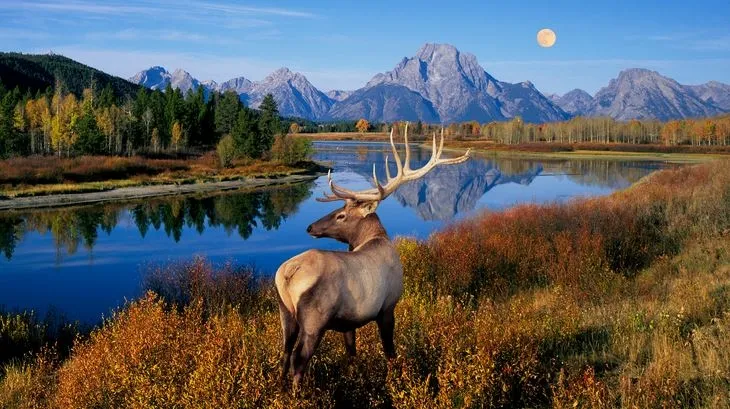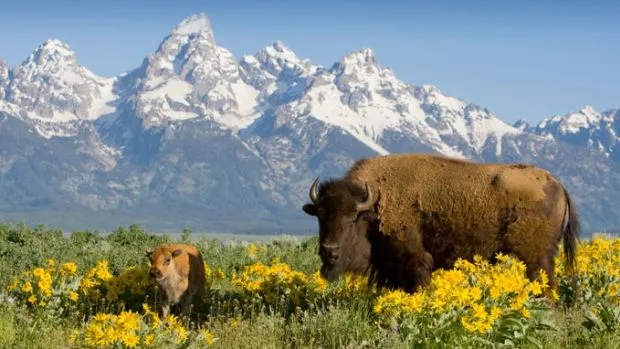Wyoming, a mountain state in the Western United States, is renowned for its majestic natural beauty and rich biodiversity. It’s not only home to the magnificent Rocky Mountains and vast grasslands but also countless rare wildlife species. Wyoming proudly boasts world-famous wildlife refuges where visitors can immerse themselves in nature, explore fascinating wildlife, and admire the unique beauty of the local ecosystem.
In this article, join “Du lịch khắp thế gian” (Travel Around the World) to explore the stunning wildlife refuges of Wyoming, where you can witness rare wild animals in their natural habitats and experience unforgettable adventures.
Grand Teton National Park – Kingdom of Wildlife
Grand Teton National Park, located in northwestern Wyoming, is a jewel in the U.S. National Park system. Spanning over 1,255 square kilometers (485 square miles), Grand Teton is famous not only for its stunning mountain scenery and pristine lakes but also as a haven for wildlife.
Grand Teton maintains a diverse natural habitat, from coniferous forests and alpine meadows to wetlands, creating ideal conditions for many animal species to live and thrive. Visiting Grand Teton offers the chance to admire rare wildlife species such as:
- Bison: Massive bison herds leisurely grazing in the vast grasslands are a signature sight of Grand Teton. You can easily spot them along the roads or during park tours.
- Moose: Grand Teton is one of the best places to observe moose in North America. This iconic animal often appears in low shrub forests or near rivers and lakes.
- Black bears and Grizzly bears: Both black bears and grizzly bears inhabit Grand Teton National Park. Black bears are more commonly seen, while grizzly bears tend to live in more remote areas. Visitors should adhere to safety precautions when exploring to avoid unwanted encounters.
- Gray wolves: After years of absence, gray wolves have returned to Grand Teton and play a crucial role in maintaining the ecosystem’s balance. You might hear their howls in the evening or early morning.
- Pronghorn: These agile animals typically inhabit the grasslands and prairies of Grand Teton. They are incredibly fast runners, escaping predators with ease.
- Red foxes: Red foxes are intelligent animals that adapt well to various habitats. You might encounter them wandering and foraging for food within the park.
- Bald eagles: The national symbol of the United States, the bald eagle, is also a resident of Grand Teton. They often nest in tall trees or cliffs and hunt fish in the lakes.

For the best wildlife viewing opportunities in Grand Teton, plan your visit in spring or fall. During these seasons, the weather is pleasant, and animals are more active. You can join eco-tours, hike on trails, or kayak on the lake to explore Grand Teton’s wildlife world.
Yellowstone National Park – Natural Wonder and Diverse Animal World
Located just north of Grand Teton, Yellowstone National Park is the first national park in the United States and one of the most famous nature reserves in the world. Yellowstone is renowned not only for its geysers, hot springs, and unique geothermal lakes but also as an ideal destination for wildlife exploration.
Covering a vast area of nearly 9,000 square kilometers (3,472 square miles), Yellowstone boasts a diverse ecosystem, from pine forests, grasslands, and alpine mountains to wetlands and geothermal areas. This diversity creates an ideal habitat for many wildlife species, including:
- Grizzly bears: Yellowstone is one of the most important areas for grizzly bear conservation in North America. The park has a healthy grizzly bear population, and visitors have opportunities to observe them in their natural habitat. However, ensuring safety during visits is extremely important.
- Gray wolves: Similar to Grand Teton, gray wolves have also successfully recovered in Yellowstone after being reintroduced in the 1990s. The return of gray wolves has had positive impacts on the park’s ecosystem.
- Bison: Yellowstone is also home to one of the largest and oldest bison herds in the United States. You can easily spot them throughout the park, especially in Hayden Valley and Lamar Valley.
- Moose: Moose are also a common animal in Yellowstone. They often appear in low shrub forests, along rivers, and lakeshores.
- Pronghorn: Pronghorn also inhabit Yellowstone, particularly in the northern grasslands of the park.
- White-tailed deer and Mule deer: Both white-tailed deer and mule deer can be found in Yellowstone. Mule deer are more common in higher mountainous areas, while white-tailed deer are better adapted to low-lying forests.
- Foxes and Coyotes: Smaller predators like red foxes, gray foxes, and coyotes also play important roles in Yellowstone’s ecosystem.
- Birds: Yellowstone is a paradise for bird lovers, with over 300 different bird species recorded, including bald eagles, hawks, owls, and various waterfowl.

To experience the amazing wildlife world of Yellowstone, you can participate in activities such as:
- Scenic drives: Drive along the park’s roads and stop at designated wildlife viewing points.
- Hiking: Yellowstone has hundreds of miles of hiking trails, from easy lakeside paths to challenging mountain trails. Hiking is a great way to explore nature and have opportunities to encounter wildlife.
- Join eco-tours: Eco-tours organized by local companies will provide you with in-depth knowledge about Yellowstone’s wildlife and ecosystem while ensuring your safety and the animals’ well-being.
- Camping: Camping in the park is a fantastic experience to immerse yourself in the wilderness and have opportunities to observe animals in the early morning or late evening.
The best time to visit Yellowstone and observe wildlife is from spring to fall. Summer is the peak tourist season but also when animals are most active. Spring and fall offer more pleasant weather and fewer crowds.
National Elk Refuge – Winter Home of Elk
The National Elk Refuge, located just south of Grand Teton National Park, is a unique refuge established in 1912 to protect the critical winter habitat of elk. In winter, thousands of elk migrate to this area to find food and shelter from harsh weather.

The refuge covers over 10,000 hectares (25,000 acres) and provides an ideal habitat for elk, including grasslands, shrub forests, and wetlands. In addition to elk, the refuge is also home to many other wildlife species such as bison, coyotes, foxes, and birds.
Visitors can explore the National Elk Refuge year-round, but the best time to observe elk is in winter (from December to March). During this time, you can join sleigh rides organized by the refuge to get closer to the massive elk herd and admire their beauty in the snowy winter landscape.
Conclusion
Wyoming is a fantastic travel destination for those who love wilderness and want to explore a diverse animal world. Wyoming’s wildlife refuges are not only places to conserve rare animal species but also offer visitors unique and unforgettable ecotourism experiences. Come to Wyoming to immerse yourself in magnificent nature, discover fascinating wildlife, and create memorable moments in your journey of exploring the world.